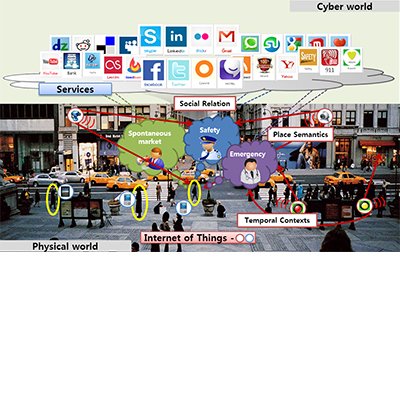Directions
Home > Research > Research Labs
협동 분산 시스템 및 네트워크 연구실

- 교수명
- 이동만
- 연구분야
- 소셜 컴퓨팅, 인터랙티브 컴퓨팅, 시스템·네트워크
- 웹사이트
- http://cds.kaist.ac.kr/cdsn/
- 이메일
- 전화번호
- 042-350-3559
- 사무실
- N1 803호
- 소개자료
- [ link1 ]
- 소개영상
- [ link1 ] [ link2 ]
오늘날 유비쿼터스 컴퓨팅이 발전하고 사물 인터넷(Internet of Things) 환경이 도래함에 따라, 사용자에게 편리한 서비스를 제공하기 위해 다양한 스마트 객체들과의 협업의 중요성이 증대되고 있다. 협동분산네트워크시스템 연구실(CDS&N Lab)은 다양한 스마트 IoT 객체들이 협업/연동되는 스마트 공간이 사용자들에게 최적의 서비스를 제공하기 위한 요소 기술 및 플랫폼을 연구 개발한다. 이를 위해 공간이 갖는 다양한 의미를 파악하고 현재 발현되는 장소성을 알아내고 또한 사용자가 현재 수행하는 태스크를 실시간으로 인지하여, 사용자 태스크 수행을 위한 최적의 서비스를 즉시적으로 제공하는 엣지 컴퓨팅 플랫폼을 연구/개발하는 것을 목표로 한다. 이를 위해 CDS&N Lab은 IT융합센터(N1)에 여러 IoT 테스트베드(각종 센서 및 스마트 가전)를 구축하고 데이터를 수집하고 서비스 제공 플랫폼의 성능을 검증한다.
[장소의 의미 파악]
사용자가 방문하고 이용하는 장소의 의미는 사용자의 의도에 따라 다르고, 시간에 따라 변화한다. 각 사용자에게 알맞은 장소와 환경을 제공하기 위해서 도시 공간 속 장소의 소셜 빅 데이터를 분석하고, GCN, Transformer 등의 다양한 머신 러닝 기법을 통해 장소의 다양한 의미를 파악하고 정형화하는 연구를 한다.
[사용자 의도 파악]
스마트 객체들의 상태를 기반하여 사용자의 의도를 실시간으로 파악하기 위해 데이타 분할을 위한 비지도학습 기반 기계 학습 기법, Transformer, Meta Learning 기반의 사용자 의도 파악 알고리즘, 최소한의 데이타로 의도를 예측하는 딥러닝 기법을 연구 개발한다
[엣지 클라우드 컴퓨팅]
스마트 공간에 파악된 사용자의 의도에 따른 최적의 서비스들을 제공하기 위해서 서비스 요구사항을 반영하는 강화학습 및 연합학습 딥러닝 기반 자원 재구성 기술, 자원 분배 및 스케줄링 연구를 진행한다.









